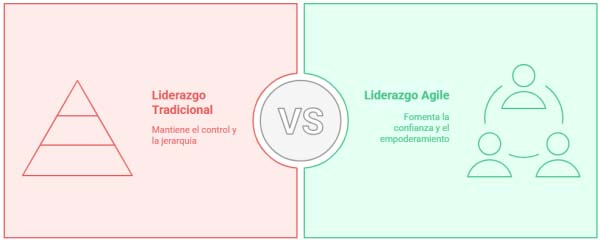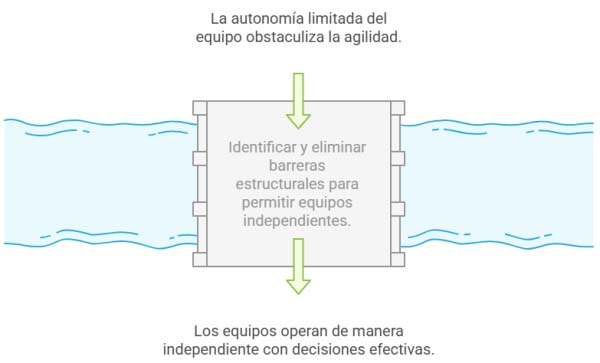
Are you familiar with any of these situations?
Do you have the feeling that something is not working… but you don’t know exactly what?
We talk about autonomy, but everything still depends on the same decisions?
Teams work differently, but results don’t change?
If you are asking yourself any of these questions, it may be time to look in a different direction.
Perhaps the biggest obstacle is not in the teams, nor in the structure, nor in the tools. It’s probably not because agility doesn’t fit your organization.
Perhaps the problem lies in how the transformation is being led.
And not because of bad intentions, but because many leaders, even with the best will, make subtle, deeply human mistakes that sabotage progress without realizing it.
Yes, it’s uncomfortable. But it’s also liberating. Because when the leadership style changes, everything changes.
In this article we will explore 7 common leadership mistakes that, when recognized and addressed, change is unlocked as if by magic.
Do you dare to look beyond the frame and ask yourself how you are leading change?
1. Maintaining old control habits under an Agile façade
This is one of the most common and difficult errors to detect. Apparently, everything has changed: there are dailies, there are boards, there are new roles. But deep down, the control model is still intact.
There is talk of autonomy, but every important decision goes through the same filter. There is talk of empowerment, but teams cannot decide priorities. There is talk of retrospectives, but what emerges from them is not really acted upon.
Leadership continues to manage on the basis of urgency, detail, doing things without understanding the why. And that has a devastating effect: the language changes, but the culture does not. And people notice it.
This type of leadership shields itself in agile practices to maintain the same power. There are Scrum meetings, but run like a military party. There are visible boards, but every move still needs authorization. Thus, agile becomes a prison with walls of post-its.

There is an exercise I love about delegation in Management 3.0: Delegation Poker.
Ask yourself: Do you trust your teams? Or do you still need to control every step? What’s stopping you from letting go of that control? What are you missing out on by not doing so?
From our Agile consulting at SmartWay, we help leaders work with the confidence, autonomy and real impact that modern leadership requires.
2. Delegating without empowering
Isn’t delegating one of the first rules for freeing the leader and empowering the team? Yes, but delegating is not the same as empowering.
Delegating tasks without transferring context, trust or decision-making capacity generates teams that execute, but do not think. People who comply, but do not get involved. Teams that constantly ask what needs to be done, because they have never been given the space to decide for themselves.
Delegating is not handing out work. It is to create the conditions so that others can make informed decisions.
False delegation is easy to spot: decisions that constantly go up and down, teams that don’t feel accountable for results, leaders exhausted by micromanaging even what they have supposedly delegated.
Tip: when delegating, also share the why, limits, leeway, risks and key information. Make sure the person can say, “I understand what I need to accomplish, why it’s important, and what decisions I can make.” If you don’t, you will remain the bottleneck.
Delegating implies accompanying, giving feedback, being available without invading. It requires investing time, but the return is immense: autonomy, responsibility, real learning.
We work on this practice with leaders in our Agile consulting, integrating tools such as Delegation Poker from Management 3.0 in order to release with confidence.
3. Applying agility without questioning the structure
Many companies want agility, but are unwilling to review how decisions are made, how performance is measured or how teams are organized. And without that, agility is just makeup.
Structure conditions behavior. As much as it hurts to manage egos, if you don’t change the structure, you won’t change the results.
This manifests itself in structures where teams remain dependent on multiple approvals, where permission must be sought to speak to the customer, where targets are assigned from the top with no room for questioning.
Real example: Scrum teams that cannot talk to the customer, nor decide the order of the backlog, nor influence the strategy. In addition to that, they depend on an external architecture department that, after setting guidelines, does not follow the development. That is not Scrum. It is theater. And it is frustrating for everyone.

Starting point: identify what structural barriers are preventing teams from functioning with real autonomy. Are there silos that continue to cascade decisions? Are there processes that paralyze rather than enable? What could you simplify or redistribute?
At SmartWay Agile Consulting, we help rethink minimum viable structures that enable fluidity without traumatic restructuring.
4. Failure to invest in middle leadership development
Middle managers are the most critical (and most forgotten) link in most agile transformations. They can no longer lead like they used to… but no one has explained to them how to do it now.
They are asked to change the way they work, to accompany the teams, to stop giving orders and start facilitating processes… but they are given neither the training, nor the accompaniment, nor the time to learn.
You can’t demand new behaviors without offering new frameworks. It’s unfair. And it’s ineffective.
The result: confusion, blockage, demotivation. Managers who feel they have lost authority, who do not know what their role is, who perceive transformation as a threat.
The paradox: they are the ones who could sustain change. Because they are close to the teams, but also connected to the strategy. Because they understand the real tensions.
In our Agile consulting, we work with middle managers to turn them into allies of change with real accompaniment and redefinition of their role.
5. Measuring success with traditional metrics
How many points did you make this week? Did you stick to the plan? Did you deliver everything?
They sound new, but they are the same old questions: efficiency over impact, control over learning.
What you measure is what really shapes behavior. If you measure the same old thing, you’ll get the same old thing.

Reflection: review your metrics: Do they reward collaboration or individual productivity? Are they connected to value delivery? Do they capture learning?
Dare to include qualitative metrics: what did we learn this iteration? what feedback did we receive?
At SmartWay, we help redesign Agile measurement systems (including OKRs) that connect with real impact. Get to know us here
6. Ignoring system signals
Agility is, above all, a way of reading and responding to the environment. But it requires listening.
Many leaders focus so much on making the new model work that they stop looking at what the system is saying: feedback, frustrations, informal indicators, recurring tensions.
Every system communicates. If you don’t listen to it, it will repeat the message in increasingly painful ways.
Tip: observe, ask questions, create safe spaces. Act on what emerges.
Agility is not directed. It is facilitated. And that is also leadership. That’s how we work every day at SmartWay.
7. Not connecting agility with purpose
What are we doing this for? Just to be faster? To make ourselves look good?
If agility is not connected to the deep purpose of the organization, it becomes just another fad. And people feel it.
Agility is a way to better serve what matters.
Make every backlog, iteration and decision answer this question:
How are we best serving what really matters?
In our Agile consulting, we work with leaders who want to reconnect the how with the why.
The catalyst for change is you
Leading in Agile is not about having all the answers. It’s about asking different questions. Listening. Changing your position. Acting differently.
Every time you choose to trust rather than control, you are sending a message: change is possible.
If you change, the system changes. And at SmartWay we are here to help you lead with purpose, presence and courage.



